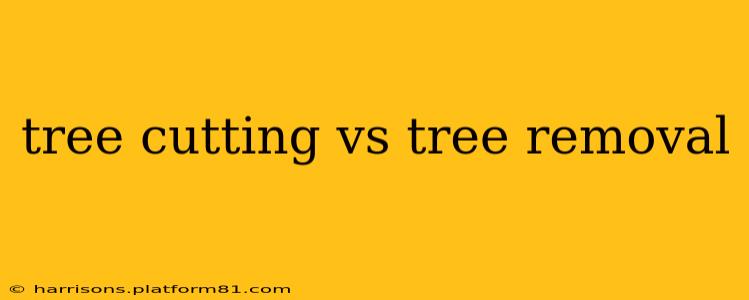Choosing between tree cutting and tree removal might seem straightforward, but there's a crucial distinction that impacts safety, cost, and the overall outcome. This guide will clarify the differences, helping you make the informed decision for your property.
What is Tree Cutting?
Tree cutting typically refers to the selective pruning or trimming of branches and the top of a tree. This process aims to improve the tree's health, shape, or remove dead or diseased wood. It doesn't necessarily involve the complete removal of the tree. Think of it as a haircut for your tree.
Key characteristics of tree cutting:
- Partial removal: Only specific parts of the tree are removed.
- Focus on maintenance: Improves tree health, aesthetics, and safety by managing growth.
- Smaller scale operation: Often requires less specialized equipment and fewer personnel.
- Lower cost: Generally less expensive than full tree removal.
What is Tree Removal?
Tree removal, on the other hand, is the complete felling and removal of a tree from its location. This is necessary when a tree is dead, diseased, damaged, poses a significant safety hazard, or obstructs construction or other projects. This is a much more extensive operation than simply cutting branches.
Key characteristics of tree removal:
- Complete removal: The entire tree, including the trunk and roots, is removed.
- Safety focus: Prioritizes preventing damage to property and injury to people.
- Larger scale operation: Requires specialized equipment, such as cranes and chippers, and experienced arborists.
- Higher cost: Substantially more expensive than simple tree cutting.
What's the Difference Between Tree Trimming and Tree Removal?
This question often arises, and while "trimming" is synonymous with "cutting" in this context, it's useful to emphasize the difference in scale. Tree trimming involves minor adjustments to improve the tree's shape and health, while tree removal is a much more comprehensive and significant undertaking.
When Should I Choose Tree Cutting/Trimming?
You should opt for tree cutting or trimming when:
- Maintaining tree health: Removing dead or diseased branches prevents further decay and disease spread.
- Improving aesthetics: Shaping the tree to enhance its appearance and complement the landscape.
- Increasing sunlight penetration: Removing lower branches allows more sunlight to reach other plants or areas.
- Preventing hazards: Removing weak or overhanging branches that might cause damage.
When Should I Choose Tree Removal?
Tree removal is necessary when:
- The tree is dead or dying: A dead tree poses a significant safety risk and can attract pests and diseases.
- The tree is diseased: Severely diseased trees may not be salvageable and could spread disease to other plants.
- The tree is damaged: Storm damage or other injuries may make the tree unstable and dangerous.
- The tree poses a safety hazard: A tree near power lines, buildings, or walkways may need to be removed for safety reasons.
- The tree obstructs construction or other projects: Removal might be necessary to allow for development.
How Much Does Tree Cutting and Tree Removal Cost?
The cost of both services varies greatly depending on factors such as:
- Size and type of tree: Larger trees require more time and resources.
- Accessibility: Difficult-to-reach trees increase the cost due to specialized equipment needs.
- Location of the tree: Removing a tree near structures or power lines adds complexity and cost.
- Geographic location: Labor costs and material prices vary by region.
- Removal of the stump: Stump grinding is an additional cost often associated with tree removal.
How Do I Find a Qualified Arborist?
Finding a qualified arborist is crucial for both tree cutting and removal. Look for:
- Certification: Ensure the arborist is certified by a reputable organization.
- Insurance and licensing: Verify they have appropriate insurance and licenses.
- Experience: Check their experience and reviews from previous clients.
- Free estimates: Obtain multiple free estimates to compare pricing and services.
By understanding the differences between tree cutting and tree removal, and by carefully choosing a qualified professional, you can ensure the safety and health of your trees and property. Remember, prevention is key. Regular tree maintenance through proper cutting and trimming can often prevent the need for more drastic removal measures in the future.
